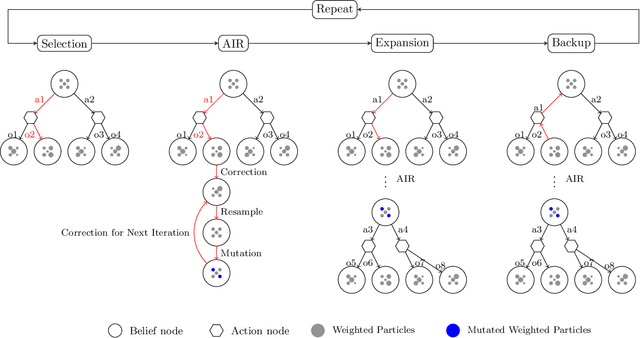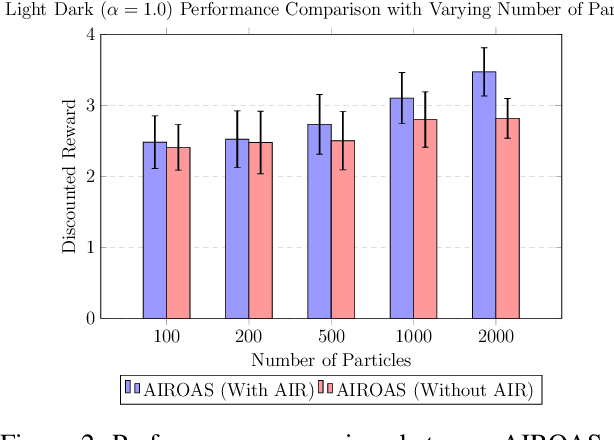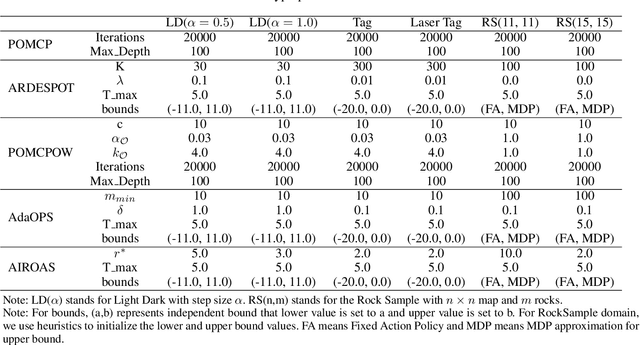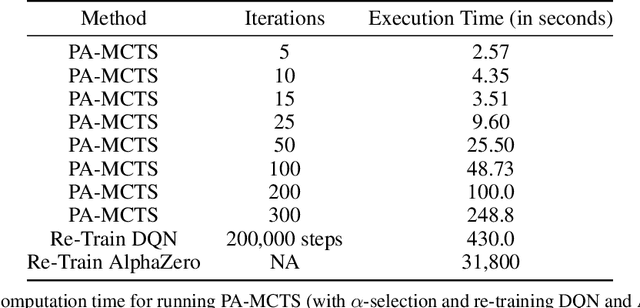Ayan Mukhopadhyay
Vanderbilt University
Combining LLMs with Logic-Based Framework to Explain MCTS
May 01, 2025

Abstract:In response to the lack of trust in Artificial Intelligence (AI) for sequential planning, we design a Computational Tree Logic-guided large language model (LLM)-based natural language explanation framework designed for the Monte Carlo Tree Search (MCTS) algorithm. MCTS is often considered challenging to interpret due to the complexity of its search trees, but our framework is flexible enough to handle a wide range of free-form post-hoc queries and knowledge-based inquiries centered around MCTS and the Markov Decision Process (MDP) of the application domain. By transforming user queries into logic and variable statements, our framework ensures that the evidence obtained from the search tree remains factually consistent with the underlying environmental dynamics and any constraints in the actual stochastic control process. We evaluate the framework rigorously through quantitative assessments, where it demonstrates strong performance in terms of accuracy and factual consistency.
Observation Adaptation via Annealed Importance Resampling for Partially Observable Markov Decision Processes
Mar 25, 2025



Abstract:Partially observable Markov decision processes (POMDPs) are a general mathematical model for sequential decision-making in stochastic environments under state uncertainty. POMDPs are often solved \textit{online}, which enables the algorithm to adapt to new information in real time. Online solvers typically use bootstrap particle filters based on importance resampling for updating the belief distribution. Since directly sampling from the ideal state distribution given the latest observation and previous state is infeasible, particle filters approximate the posterior belief distribution by propagating states and adjusting weights through prediction and resampling steps. However, in practice, the importance resampling technique often leads to particle degeneracy and sample impoverishment when the state transition model poorly aligns with the posterior belief distribution, especially when the received observation is highly informative. We propose an approach that constructs a sequence of bridge distributions between the state-transition and optimal distributions through iterative Monte Carlo steps, better accommodating noisy observations in online POMDP solvers. Our algorithm demonstrates significantly superior performance compared to state-of-the-art methods when evaluated across multiple challenging POMDP domains.
Scalable Decision-Making in Stochastic Environments through Learned Temporal Abstraction
Feb 28, 2025Abstract:Sequential decision-making in high-dimensional continuous action spaces, particularly in stochastic environments, faces significant computational challenges. We explore this challenge in the traditional offline RL setting, where an agent must learn how to make decisions based on data collected through a stochastic behavior policy. We present \textit{Latent Macro Action Planner} (L-MAP), which addresses this challenge by learning a set of temporally extended macro-actions through a state-conditional Vector Quantized Variational Autoencoder (VQ-VAE), effectively reducing action dimensionality. L-MAP employs a (separate) learned prior model that acts as a latent transition model and allows efficient sampling of plausible actions. During planning, our approach accounts for stochasticity in both the environment and the behavior policy by using Monte Carlo tree search (MCTS). In offline RL settings, including stochastic continuous control tasks, L-MAP efficiently searches over discrete latent actions to yield high expected returns. Empirical results demonstrate that L-MAP maintains low decision latency despite increased action dimensionality. Notably, across tasks ranging from continuous control with inherently stochastic dynamics to high-dimensional robotic hand manipulation, L-MAP significantly outperforms existing model-based methods and performs on-par with strong model-free actor-critic baselines, highlighting the effectiveness of the proposed approach in planning in complex and stochastic environments with high-dimensional action spaces.
Reinforcement Learning-based Approach for Vehicle-to-Building Charging with Heterogeneous Agents and Long Term Rewards
Feb 24, 2025Abstract:Strategic aggregation of electric vehicle batteries as energy reservoirs can optimize power grid demand, benefiting smart and connected communities, especially large office buildings that offer workplace charging. This involves optimizing charging and discharging to reduce peak energy costs and net peak demand, monitored over extended periods (e.g., a month), which involves making sequential decisions under uncertainty and delayed and sparse rewards, a continuous action space, and the complexity of ensuring generalization across diverse conditions. Existing algorithmic approaches, e.g., heuristic-based strategies, fall short in addressing real-time decision-making under dynamic conditions, and traditional reinforcement learning (RL) models struggle with large state-action spaces, multi-agent settings, and the need for long-term reward optimization. To address these challenges, we introduce a novel RL framework that combines the Deep Deterministic Policy Gradient approach (DDPG) with action masking and efficient MILP-driven policy guidance. Our approach balances the exploration of continuous action spaces to meet user charging demands. Using real-world data from a major electric vehicle manufacturer, we show that our approach comprehensively outperforms many well-established baselines and several scalable heuristic approaches, achieving significant cost savings while meeting all charging requirements. Our results show that the proposed approach is one of the first scalable and general approaches to solving the V2B energy management challenge.
NS-Gym: Open-Source Simulation Environments and Benchmarks for Non-Stationary Markov Decision Processes
Jan 16, 2025



Abstract:In many real-world applications, agents must make sequential decisions in environments where conditions are subject to change due to various exogenous factors. These non-stationary environments pose significant challenges to traditional decision-making models, which typically assume stationary dynamics. Non-stationary Markov decision processes (NS-MDPs) offer a framework to model and solve decision problems under such changing conditions. However, the lack of standardized benchmarks and simulation tools has hindered systematic evaluation and advance in this field. We present NS-Gym, the first simulation toolkit designed explicitly for NS-MDPs, integrated within the popular Gymnasium framework. In NS-Gym, we segregate the evolution of the environmental parameters that characterize non-stationarity from the agent's decision-making module, allowing for modular and flexible adaptations to dynamic environments. We review prior work in this domain and present a toolkit encapsulating key problem characteristics and types in NS-MDPs. This toolkit is the first effort to develop a set of standardized interfaces and benchmark problems to enable consistent and reproducible evaluation of algorithms under non-stationary conditions. We also benchmark six algorithmic approaches from prior work on NS-MDPs using NS-Gym. Our vision is that NS-Gym will enable researchers to assess the adaptability and robustness of their decision-making algorithms to non-stationary conditions.
Shrinking POMCP: A Framework for Real-Time UAV Search and Rescue
Nov 20, 2024



Abstract:Efficient path optimization for drones in search and rescue operations faces challenges, including limited visibility, time constraints, and complex information gathering in urban environments. We present a comprehensive approach to optimize UAV-based search and rescue operations in neighborhood areas, utilizing both a 3D AirSim-ROS2 simulator and a 2D simulator. The path planning problem is formulated as a partially observable Markov decision process (POMDP), and we propose a novel ``Shrinking POMCP'' approach to address time constraints. In the AirSim environment, we integrate our approach with a probabilistic world model for belief maintenance and a neurosymbolic navigator for obstacle avoidance. The 2D simulator employs surrogate ROS2 nodes with equivalent functionality. We compare trajectories generated by different approaches in the 2D simulator and evaluate performance across various belief types in the 3D AirSim-ROS simulator. Experimental results from both simulators demonstrate that our proposed shrinking POMCP solution achieves significant improvements in search times compared to alternative methods, showcasing its potential for enhancing the efficiency of UAV-assisted search and rescue operations.
Enabling MCTS Explainability for Sequential Planning Through Computation Tree Logic
Jul 15, 2024



Abstract:Monte Carlo tree search (MCTS) is one of the most capable online search algorithms for sequential planning tasks, with significant applications in areas such as resource allocation and transit planning. Despite its strong performance in real-world deployment, the inherent complexity of MCTS makes it challenging to understand for users without technical background. This paper considers the use of MCTS in transportation routing services, where the algorithm is integrated to develop optimized route plans. These plans are required to meet a range of constraints and requirements simultaneously, further complicating the task of explaining the algorithm's operation in real-world contexts. To address this critical research gap, we introduce a novel computation tree logic-based explainer for MCTS. Our framework begins by taking user-defined requirements and translating them into rigorous logic specifications through the use of language templates. Then, our explainer incorporates a logic verification and quantitative evaluation module that validates the states and actions traversed by the MCTS algorithm. The outcomes of this analysis are then rendered into human-readable descriptive text using a second set of language templates. The user satisfaction of our approach was assessed through a survey with 82 participants. The results indicated that our explanatory approach significantly outperforms other baselines in user preference.
Forecasting and Mitigating Disruptions in Public Bus Transit Services
Mar 06, 2024



Abstract:Public transportation systems often suffer from unexpected fluctuations in demand and disruptions, such as mechanical failures and medical emergencies. These fluctuations and disruptions lead to delays and overcrowding, which are detrimental to the passengers' experience and to the overall performance of the transit service. To proactively mitigate such events, many transit agencies station substitute (reserve) vehicles throughout their service areas, which they can dispatch to augment or replace vehicles on routes that suffer overcrowding or disruption. However, determining the optimal locations where substitute vehicles should be stationed is a challenging problem due to the inherent randomness of disruptions and due to the combinatorial nature of selecting locations across a city. In collaboration with the transit agency of Nashville, TN, we address this problem by introducing data-driven statistical and machine-learning models for forecasting disruptions and an effective randomized local-search algorithm for selecting locations where substitute vehicles are to be stationed. Our research demonstrates promising results in proactive disruption management, offering a practical and easily implementable solution for transit agencies to enhance the reliability of their services. Our results resonate beyond mere operational efficiency: by advancing proactive strategies, our approach fosters more resilient and accessible public transportation, contributing to equitable urban mobility and ultimately benefiting the communities that rely on public transportation the most.
Act as You Learn: Adaptive Decision-Making in Non-Stationary Markov Decision Processes
Jan 15, 2024



Abstract:A fundamental (and largely open) challenge in sequential decision-making is dealing with non-stationary environments, where exogenous environmental conditions change over time. Such problems are traditionally modeled as non-stationary Markov decision processes (NSMDP). However, existing approaches for decision-making in NSMDPs have two major shortcomings: first, they assume that the updated environmental dynamics at the current time are known (although future dynamics can change); and second, planning is largely pessimistic, i.e., the agent acts ``safely'' to account for the non-stationary evolution of the environment. We argue that both these assumptions are invalid in practice -- updated environmental conditions are rarely known, and as the agent interacts with the environment, it can learn about the updated dynamics and avoid being pessimistic, at least in states whose dynamics it is confident about. We present a heuristic search algorithm called \textit{Adaptive Monte Carlo Tree Search (ADA-MCTS)} that addresses these challenges. We show that the agent can learn the updated dynamics of the environment over time and then act as it learns, i.e., if the agent is in a region of the state space about which it has updated knowledge, it can avoid being pessimistic. To quantify ``updated knowledge,'' we disintegrate the aleatoric and epistemic uncertainty in the agent's updated belief and show how the agent can use these estimates for decision-making. We compare the proposed approach with the multiple state-of-the-art approaches in decision-making across multiple well-established open-source problems and empirically show that our approach is faster and highly adaptive without sacrificing safety.
Decision Making in Non-Stationary Environments with Policy-Augmented Search
Jan 06, 2024



Abstract:Sequential decision-making under uncertainty is present in many important problems. Two popular approaches for tackling such problems are reinforcement learning and online search (e.g., Monte Carlo tree search). While the former learns a policy by interacting with the environment (typically done before execution), the latter uses a generative model of the environment to sample promising action trajectories at decision time. Decision-making is particularly challenging in non-stationary environments, where the environment in which an agent operates can change over time. Both approaches have shortcomings in such settings -- on the one hand, policies learned before execution become stale when the environment changes and relearning takes both time and computational effort. Online search, on the other hand, can return sub-optimal actions when there are limitations on allowed runtime. In this paper, we introduce \textit{Policy-Augmented Monte Carlo tree search} (PA-MCTS), which combines action-value estimates from an out-of-date policy with an online search using an up-to-date model of the environment. We prove theoretical results showing conditions under which PA-MCTS selects the one-step optimal action and also bound the error accrued while following PA-MCTS as a policy. We compare and contrast our approach with AlphaZero, another hybrid planning approach, and Deep Q Learning on several OpenAI Gym environments. Through extensive experiments, we show that under non-stationary settings with limited time constraints, PA-MCTS outperforms these baselines.
 Add to Chrome
Add to Chrome Add to Firefox
Add to Firefox Add to Edge
Add to Edge